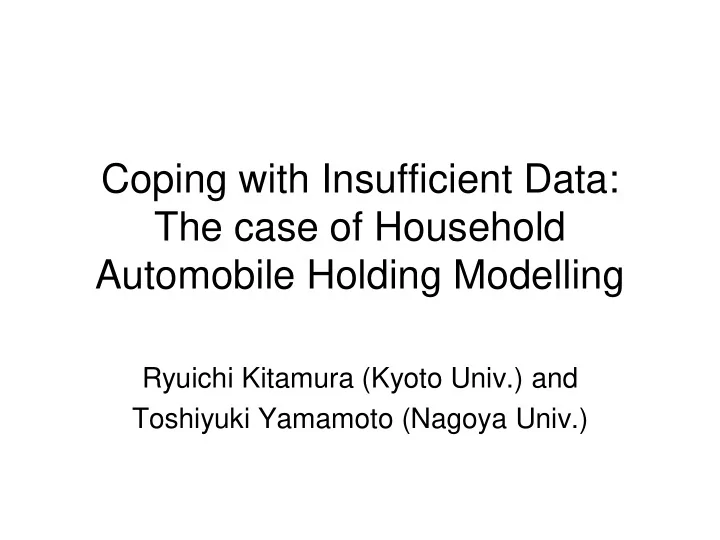

Coping with Insufficient Data: The case of Household Automobile Holding Modelling Ryuichi Kitamura (Kyoto Univ.) and Toshiyuki Yamamoto (Nagoya Univ.)
Motivation: Insufficient data • It is often the case that typically available data do not contain all the variables that are desired for the analysis of the behavior of interest. • In case of the analysis of household automobile holding behavior, information on the cost of holding an automobile is rarely available in data – make and model of the automobile, acquired new or used, purchase price, fuel consumption rate, or insurance costs—is typically unavailable. 2005/09/26 SAKURA Seminar at INRETS 2
Objective: A possible approach A theoretical model – based on external principles – embodies relationships among observed variables. In this study , A utilitarian model of household automobile holding is developed – based on the assumption that a household holds an optimum number of automobiles at the time of observation. 2005/09/26 SAKURA Seminar at INRETS 3
Key: Base auto ownership cost • Purchase price is not available But • minimum fixed cost per unit time to hold an automobile can be assumed • Each household is assumed to spend a nonnegative amount of money in addition to the base cost to hold a better automobile that offers more amenities 2005/09/26 SAKURA Seminar at INRETS 4
Utility model Assumption • Household optimizes its vehicle holding and use Model • expresses the utility of automobile holding in terms of income and household size • without requiring variables that can hardly be measured, e.g., unit cost of auto and transit travel 2005/09/26 SAKURA Seminar at INRETS 5
α η n β γ δ = = ( , , , | ) A U U M M A X n M M A X A T A A T n H Modifier that represents effect of auto availability n A = number of automobiles n H = number of adult household members M A = mobility by automobile per adult household member (person-km) M T = mobility by public transit per adult household member (person-km) A = auto amenities expenditure per automobile X = expenditure per adult household member for other goods 2005/09/26 SAKURA Seminar at INRETS 6
Subject to • Income constraint • Minimum mobility requirements be met • Ceiling on the use of household automobiles in terms of total vehicle kilometers. + + + + = ( ) n p M n p M n qA C n pX Y H A A H T T A H + ≥ ( ) ( ) n M M M Z H A T n M ≤ H A ( ) M Z n A 2005/09/26 SAKURA Seminar at INRETS 7
Income constraint + + + + = ( ) n p M n p M n qA C n pX Y H A A H T T A H p A = auto variable cost (per person-km) p T = transit variable cost (per person-km) q = unit auto amenity cost = base auto cost per unit time C p = price of other goods 2005/09/26 SAKURA Seminar at INRETS 8
Minimum mobility requirements + ≥ ( ) ( ) n M M M Z H A T Household has a larger mobility than the minimum mobility ( ) M Z Ceiling on use of automobiles n M ≤ H A ( ) M Z n A Mobility by automobile can be served by ( ) household fleet M Z 2005/09/26 SAKURA Seminar at INRETS 9
Unbounded solution • Unbounded solution ignore 2nd and 3th constraints • By introducing random error terms • We get indirect utility below β + + α + η + + ε = ( 1)ln (1 )ln (0) if 0 Y n C n = H i A * ( ) U n α + β + γ + − − γ − αη + ε = i A ( 1)ln( ) ( )ln ( ) if 1,2,... Y n C n n n A A i A A • which doesn’t require variable costs, nor purchase price 2005/09/26 SAKURA Seminar at INRETS 10
Future tasks • Estimation of discrete choice model – Base automobile cost is unknown. It is proposed that alternative values be postulated for when estimating the model • Boundary solutions must be incorporated into the estimation process 2005/09/26 SAKURA Seminar at INRETS 11
Recommend
More recommend